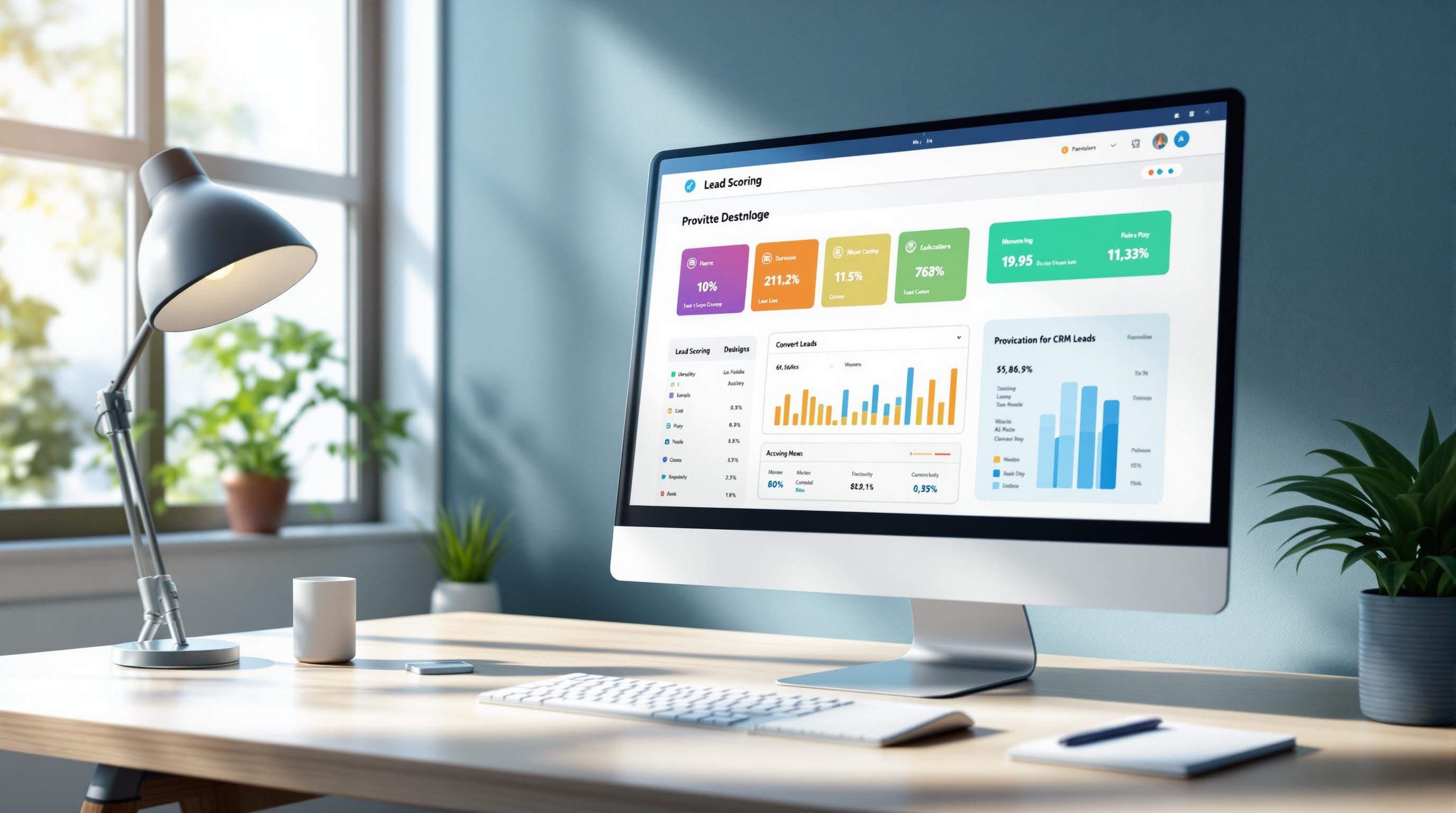Want to grow your sales? Automating lead management with CRM tools is the way forward. Here's why: CRM systems not only manage leads but also streamline the entire customer lifecycle, helping businesses save time, improve collaboration, and close deals faster.
Key Takeaways:
- Sales Leads: Potential customers identified through data or direct contact.
- CRM Systems: Tools to manage customer relationships, track interactions, and automate workflows.
- Integration Benefits: Unified data, automated processes, better analytics, and higher productivity.
- Lead Management Tools: Popular options include Salesforce, HubSpot, Zoho CRM, and Pipedrive.
- Lead Scoring: Focus on high-potential prospects using automated scoring rules.
- AI in Lead Management: Predictive scoring, engagement tracking, and smart chatbots enhance efficiency.
Quick Comparison Table:
| Aspect | Lead Management | CRM System |
|---|---|---|
| Primary Focus | Generating and qualifying leads | Managing the entire customer lifecycle |
| Data Handling | Basic lead details | Detailed customer history |
| Functionality | Lead scoring, qualification | Automation for sales, marketing, and service |
| Timeline Coverage | First contact to qualification | Entire relationship lifecycle |
How Lead Management Works In 2024
Connecting Lead Management to CRM
Integrating lead management with CRM systems can significantly boost sales efficiency and streamline processes.
Advantages of Integration
Bringing lead management and CRM systems together offers several key benefits for sales teams:
| Advantage | Impact |
|---|---|
| Unified Database | A single, reliable source for all customer data |
| Automated Workflows | Reduces the need for manual data entry |
| Improved Collaboration | Aligns sales and marketing efforts effectively |
| Better Analytics | Provides a clear view of the entire lead-to-customer journey |
| Higher Productivity | Frees up more time for selling by cutting down administrative tasks |
Steps to Integrate Your Systems
Ready to link your lead management and CRM tools? Here’s how to make it happen:
-
Assessment Phase
Start by reviewing your current systems. Identify your integration needs, including data flow requirements, team capacity, and budget considerations [1]. -
Tool Selection
Opt for systems that support native integrations or work with third-party connectors. Examples include HubSpot's CRM, Salesforce paired with Pardot, or Pipedrive with its built-in lead management features. -
Data Migration
Carefully transfer your lead and customer data. Clean up records, map fields, validate the transfers, and always back up your data to prevent loss.
Following these steps will help ensure your integration is smooth and delivers the benefits outlined above.
Lead Management Tools and Software
Sales processes have become more efficient thanks to tools that combine automation and intelligence. Below, we’ll look at some effective solutions and strategies to improve lead management.
Popular Lead Management Software
There are several tools available today that can help businesses manage leads more effectively:
| Tool | Key Features | Best For | Starting Price |
|---|---|---|---|
| Salesforce | Sales automation, AI insights, customization | Enterprise businesses | $25/user/month |
| HubSpot | Free CRM, marketing hub, visual pipeline | Growing companies | Free (basic); $15/seat/month (Sales Hub) |
| Zoho CRM | Workflow automation, social media integration | Small businesses | Free (basic); $14/user/month |
| Freshsales | Built-in phone/email, AI contact scoring | Sales teams | $9/user/month |
| Pipedrive | Visual pipeline, email integration | Sales-focused teams | $14/seat/month |
Setting Up Lead Scoring
Lead scoring helps you identify and focus on prospects most likely to convert. Here’s how to set it up:
-
Define Your Criteria
Use demographic, engagement, and behavior data to create a scoring framework. For example, HubSpot allows you to assign points for actions like website visits, email opens, or booking a meeting. -
Implement Scoring Rules
Automate score adjustments based on prospect interactions. For example, Guild Mortgage reported that their loan officers responded to leads twice as fast after using automated scoring to flag high-value prospects [3]. -
Monitor and Adjust
Regularly review and tweak your scoring system to ensure it aligns with your business goals and keeps pace with market changes.
AI Tools for Lead Analysis
AI-powered tools have transformed lead analysis and outreach with features like:
- Predictive scoring: Identifies high-potential leads using historical data.
- Engagement tracking: Monitors interactions across email, social media, and more.
- Data enrichment: Automatically adds verified details to lead profiles.
- Smart chatbots: Engages prospects and qualifies them through conversations.
One example is Infocus Technologies, which uses Leadzen.ai to improve lead accuracy:
"Leadzen.ai has been a game-changer for us, converting potential losses into victories by furnishing accurate, verified contact information." [2]
The growing role of AI in lead management is evident, with over 50% of marketers worldwide now relying on AI tools for lead generation and qualification [2].
sbb-itb-8aac02d
Lead Nurturing Through CRM
Creating Custom Lead Campaigns
CRM tools allow you to design campaigns tailored to how leads behave. For instance, you could set up a drip campaign that starts with a warm, personalized welcome email. After that, you might showcase key product features, share success stories, and finish with a limited-time offer to drive action.
Mixing Automation with Personal Contact
After creating campaigns, it's all about finding the right balance between automation and personal touch. Imagine this: a prospect downloads an ebook through Mailchimp and checks out a pricing page on HubSpot. The CRM could then automatically send a welcome email, follow up with product insights and testimonials, and even offer a custom promotion to seal the deal.
"AI-powered CRM and marketing automation deliver hyper-personalized experiences, improving customer satisfaction, engagement, and loyalty." - SolveForce Communications [4]
Lead Nurturing Tips
Here are some practical tips to fine-tune your lead nurturing strategy:
- Map the Buyer's Journey: Keep track of how leads interact with your brand to understand their decision-making process. This method can generate 50% more sales-ready leads while cutting the cost per lead by 33% [6].
- Segment Strategically: Group leads into categories based on factors like industry, company size, engagement level, purchase history, or website activity. This makes your efforts more targeted and effective.
- Time Your Communications: Use automated responses triggered by specific actions. For example, if someone visits a product page, follow up with a case study or invite them to a demo.
- Focus on Value First: Share useful, educational content before jumping into sales pitches. Did you know businesses have a 60–70% chance of selling to existing customers compared to just a 5–20% chance with new ones? [5] Prioritizing value builds trust and loyalty.
Tracking Lead Management Results
Tracking metrics is essential to ensure your automated lead management strategies are delivering measurable outcomes.
Lead Management Metrics
Focusing on key performance indicators (KPIs) can help identify both strengths and areas needing improvement. Did you know that sales teams often spend up to 66% of their workday chasing leads that are unlikely to convert? [7].
| Metric | Description | Impact |
|---|---|---|
| Lead Quality Score | Evaluates how well a lead fits and engages | Prioritizes high-potential leads |
| Cost per Lead (CPL) | Total spend divided by leads generated | Measures campaign efficiency |
| Lead-to-Customer Rate | Percentage of leads that convert into customers | Tracks conversion success |
| Sales Velocity | Speed at which leads move through the pipeline | Highlights process efficiency |
| Customer Acquisition Cost (CAC) | Total cost to acquire new customers | Reflects ROI of lead efforts |
It’s smarter to focus on lead quality rather than sheer volume. Companies with well-aligned marketing and sales teams are three times more likely to surpass their customer acquisition targets [7]. This makes assessing lead quality a crucial next step.
Lead Quality Assessment
To evaluate lead quality, a structured approach using your CRM system is key. Automated tools for lead scoring and assessment analyze factors like engagement levels, demographic alignment, and interaction history. Modern CRM platforms make this easier with features like behavioral tracking and demographic scoring. Considering that 97% of leads aren’t ready to buy immediately [9], accurate assessments help prioritize resources effectively. For instance, companies using heatmap tools to study lead behavior often see a 20% increase in conversion rates [10].
These quality assessments lay the groundwork for actionable improvements.
Making Regular Improvements
-
Regular Data Review
Use analytics to review month-to-date performance compared to your KPIs [8]. -
Response Time Optimization
Companies that respond to inbound requests within three minutes see a 70% success rate [8]. -
Channel Performance Analysis
Identify which channels generate the best leads. Personalized marketing can increase conversion rates by 29% [10].
Consistent tracking and adjustments can boost marketing effectiveness by an average of 8% [10]. Companies with strong alignment between marketing and sales grow 19% faster and are 15% more profitable [7]. Establishing a formal service-level agreement (SLA) between these teams can define roles and set measurable goals, driving even greater results.
Conclusion: Growing Through Better Lead Management
Main Points Review
Integrating sales leads with CRM automation can transform your sales process and drive growth. For instance, automated CRM lead management has been shown to increase qualified leads by up to 451% [13] while minimizing costly errors - errors that amount to $3 trillion in losses for U.S. businesses annually [11].
Here’s a quick breakdown of the benefits:
| Benefit | Impact | Outcome |
|---|---|---|
| Operational Efficiency | Cuts down on manual tasks | Sales teams recover 50% of the time spent on unproductive prospecting [11] |
| Data Centralization | Enhances lead quality | Better segmentation and more precise targeting |
| Sales Acceleration | Speeds up conversions | Faster deal closures and higher ROI |
These advantages create a strong foundation for improving your sales strategy.
Getting Started
Ready to make the most of these benefits? Here’s how you can begin:
Morning Fresh, for example, linked their customer database with MailChimp to refine lead segmentation and email targeting. The result? A significant increase in conversions [12].
-
Evaluate Your Processes
Start by auditing your current lead workflows. Identify any bottlenecks or manual tasks slowing you down. -
Pick the Right Tools
Select CRM tools that align with your existing systems. For example, Veo used Zapier to connect ActiveCampaign and Pipedrive. This move reduced their cost-per-lead by 20% and helped them double their business in just 18 months [14].
"Zapier allows you to automate your entire lead lifecycle - from capturing that lead, adding it to your CRM, routing it to the right team, and then triggering the appropriate outreach." - Zapier [14]


